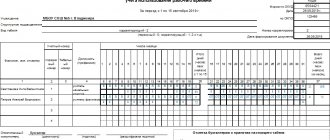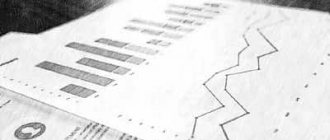Stage of preparation for timing of working hours
At the preparatory stage of working time timing, it is necessary to carry out:
- The choice of observed workers, depending on the purposes of timing working hours.
- Drawing up a list of technological operations, the time of which will be measured during timing observations.
- Calculation of the required number of measurements.
- Preparation of blank working time card forms, sample and example, see below.
Observed workers for the purpose of developing labor standards should be selected from among employees with average productivity. If there is a large share of physical labor, it is necessary to select performers with average psychophysical data. It is advisable to exclude newcomers and workers with extensive experience from observation.
If the purpose of timing working hours, for example, is to establish factors for non-compliance with labor standards, two samples of performers should be formed for observation - those who consistently do not fulfill and those who consistently exceed the established standards. Psychophysical data and work experience are not important.
In the case when the purpose of timing working hours is to increase labor productivity, the best workers, “the forefront of production,” can be the model for observation.
Determination of the composition of technological operations is usually carried out before the start of timing, during the photography of working hours. The PDF allows you to study various options for standard sets of work operations and create a target list. It is desirable that the target set of work operations be agreed upon by the technical and production services of enterprises.
The convenience of taking measurements when timing working hours depends on the choice of fixed observation points for each working operation. Fixation points establish the boundaries of the beginning and end of operations, and ideally should be accompanied by clearly visible external signs - worker movements, tool sounds or equipment signals. Examples of fixing points for timing working time: the beginning of movement of the mechanism, the sound of a blow when removing a part, the worker moving to another machine, etc.
Rice. 1. Sample of filling out the list of technological operations for timing working hours (example).
To calculate the required number of observations when timing working hours, the stability coefficient of the time series is used. The use of this coefficient allows us to stabilize the sample of values obtained during observations, excluding extreme (minimum and maximum) values that are considered random. A sample in which the ratio of the minimum value to the maximum value is less than the standard stability coefficient of the chronosequence is considered stable. To determine this coefficient, you can use the following table:
Rice. 2. Sample (example) of the number of measurements for timing working hours.
The number of necessary observations (measurements) of each technological operation is indicated in the cells of this table and depends on the type of production, the nature of the work and the duration of the operation. In parentheses of the table cells, the stability coefficients of the time series are given for reference, which will be needed later when processing the observation results to exclude random values.
Main stages
In order to carry out the process of certifying an employee’s working time efficiently, it is necessary to follow a certain algorithm. In total, timing is divided into three main stages:
- Preparatory , when the necessary documentation is prepared, employees are notified and instructions are provided to observers;
- The verification stage itself ;
- Conclusions that are drawn based on data from the chronocard. Most often, this procedure is carried out by the head of the enterprise or high-ranking managers.
The process itself is carried out according to a certain scheme. To begin with, inspectors must familiarize themselves with the work standards . This will make it possible to more clearly identify deviations from the established parameters. Most often, the enterprise already has specific working standards.
Read more: Is it possible to quit while on sick leave?
If the department is new, timekeeping can be used to determine them. To do this, observation is carried out on the best and most advanced employees of the company. Their indicators should become working standards for all company employees working in a certain area.
The procedure for measuring working time involves recording in a document each work process on which an employee spends time . Here the beginning and end of the period of execution of a separate operation or group of works is recorded.
The observer’s task will be to record in the table all data regarding not only the work, but also the employee’s rest . There should be a special column where the number of breaks and their duration are noted.
Ultimately, it will be possible to determine exactly how much time was spent on working duties, how much on rest and on preparing for the work process. The prepared papers are submitted for consideration to senior management , who will make the final conclusions.
Sample filling and example of a work time sheet
The final part of the preparatory stage is the preparation of working time sheets.
Rice. 3. Sample of filling out a working time card
Filling out a sample working time card:
- The lines list sequentially the technological operations of the type of work being measured (in our example, unloading cars).
- The table in Figure 2 determines the number of required measurements for each operation.
- The recorded operation time is entered in the cells of the corresponding line, in the example - 19 measurements of the “Lifting pallets” operation.
- We calculate the stability coefficient of the chronological sequence (divide the maximum operation time by the minimum). If it turns out to be less than the standard value (Figure 2), then we save all the measurements taken. If the actual coefficient exceeds the standard, we exclude extreme measurements until it returns to normal.
- We calculate the resulting average analytical time (the sum of all measurements divided by their number).
- After performing measurements and calculations for all operations included in the work, we calculate the total time for this type of work - this is the time of operational work and the goal of our research.
https://youtu.be/T8m8pHDftIs
Timing: sample
The object of observation is social workers who provide services at home. The objective of the study is to assess employees’ working time and identify reserves for the rational use of work activity.
The preparatory stage will be the creation of a commission for measurements and processing of results. For timing purposes, a time period of 3 working days is selected.
Employee #1
| date | the name of the operation | Duration, min |
| 10.02 | Purchase and home delivery of products | 57 |
| 11.02 | Purchase and home delivery of products | 48 |
| 12.02 | Purchase and home delivery of products | 49 |
| Average duration | 57+48+49/3=51 | |
Employee #2
| date | the name of the operation | Duration, min |
| 10.02 | Purchase and home delivery of products | 50 |
| 11.02 | Purchase and home delivery of products | 45 |
| 12.02 | Purchase and home delivery of products | 52 |
| Average duration | 50+45+52/3=49 | |
The overall average time is: (51+49):2=50 minutes.
The timing of the social worker’s working hours showed that to complete the task for the specified service, the worker needs to spend 50 minutes. You can also count the number of clients served during the month and distribute the workload of employees.
An example of working time tracking
Before the start of observation, it is necessary to check the presence of normal (typical) working conditions at the workplace and prepare the observed employee - talk about the goals of the event and discuss the observation procedure.
To keep track of working hours, conventional electronic stopwatches are used, ideally with a function for storing measurement results in memory - this will allow data to be entered into a table based on the results of a series of measurements and will speed up the work of the standardizer.
There are several ways to track working hours. With continuous timing, observation is carried out continuously until the required number of measurements is obtained. This method can be used in mass production with constantly repeating cycles of work. With this method, you can get by with only the initial fixation points, since the end of one operation coincides with the beginning of the next.
In some cases, the organization of work does not allow organizing timekeeping in a continuous manner, and then the method of selective timekeeping is used. The difference lies in the ability to measure separately each operation included in the work with measurements of the starting and ending fixing points.
Disadvantages of Timekeeping
- Dependence of the reliability of the results on the choice of object of observation.
- The data obtained are subjective, since the time standard is assessed according to one criterion - the impracticability of the duration of the operation.
- Difficulties in estimating lost time. To identify them, a project of a rational labor process is needed.
- Inability to accurately record working hours on short-term operations.
- The impossibility of comparing the time spent on the same operations at different enterprises.
Processing results of working time timing
Processing the results of working time timing consists of analyzing the stability coefficients of the time series, calculating the average analytical time for each operation and summing up the measurement results.
Based on the results of the analysis of the actual time of work operations, labor standards are established, proposals are developed to increase labor productivity and the speed of operations performed, and an analysis is carried out of the compliance of the obtained standards with the approved ones and with the actual output.
How is timing data collected?
This problem can be solved by:
- manually entering data into timekeeping forms;
- automated data entry into appropriate forms.
In the first case, the main actions may be assigned to the employee himself or to a responsible person who will supervise the employee’s work. The second option for collecting timing data involves the use of various computer algorithms.
The choice of the first or second option for data collection depends on the specifics of the employee’s specific job function, as well as on the technical ability and efficiency of recording this or that type of data for timing in the first or second way.
For example, if we are talking about recording data on the use of programs specialized for a person’s work function, then the optimal way to solve this problem is automation, which involves the use of other programs that can track the intensity with which the employee accesses his software.
When it comes to timing the stages of a product assembly line, it may be preferable (due to less complex technical feasibility) to use a method of manually entering data into the timing form.
Once the timing data is collected, the employee or his colleague who has the necessary competencies has another task - to correctly interpret the statistics obtained.








